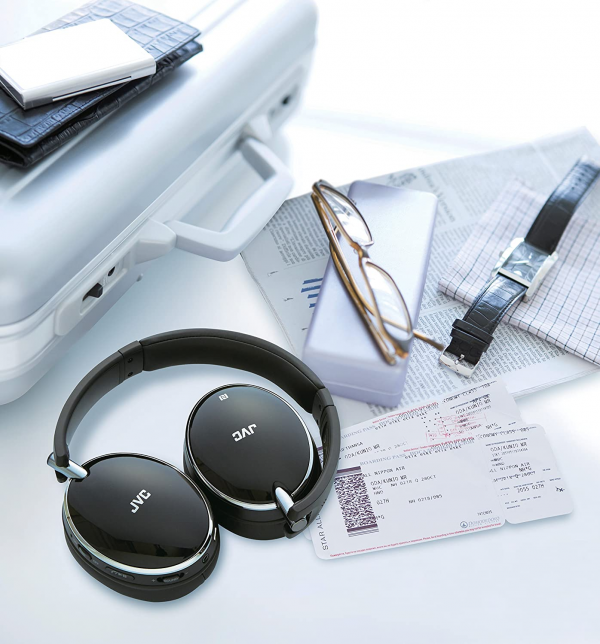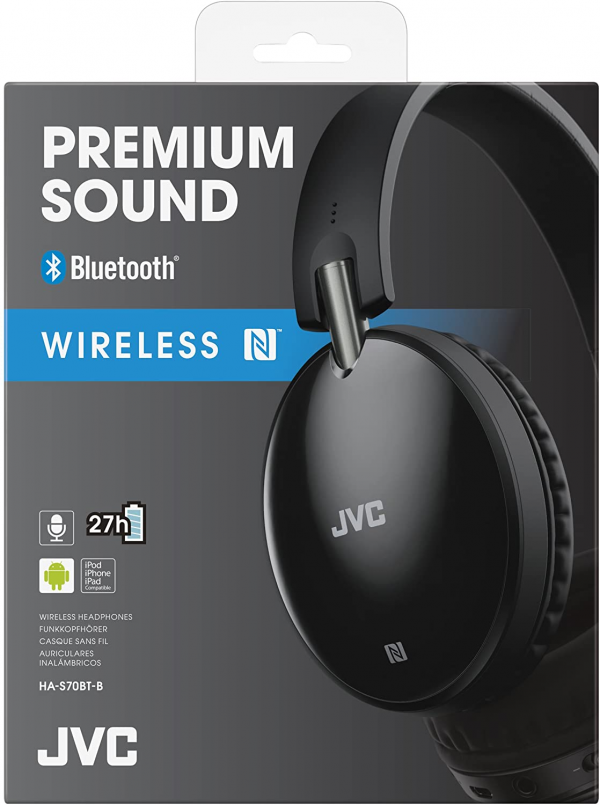JVC
JVC HA-S70BT: an economical Bluetooth headset
Aprox. 84€ - see price -
The recipe for most JVC helmets is simple: an anonymous but effective design, functionality reduced to a minimum, and an emphasis on value for money. The HA-S70BT Bluetooth headset is no exception to this rule, perhaps not enough ...
Our review
Ergonomics
From the unpacking of the helmet, the impression given by the helmet only deserves the qualifier of cheap. Made of plastic and synthetic leather frankly little tempting, the HA-S70BT also shows a very simplistic construction and shows its visible screws with very little modesty. Only metallic notes to find on the helmet, the aluminum of the slider of the headband and the hinges of the ear cups - an appreciable choice on the part of the manufacturer since it should make it possible to confer good durability on these two parts which are well often fragile on nomadic helmets.
Admittedly, this very simple construction allows the helmet to fall into the featherweight category: less than 200 grams on the scale. However, this does not make it a model of comfort. In cause, the lack of articulation of the auricles on the horizontal axis, which causes a rather bad distribution of the pressure on the circumference of the ear. But for some users, it is above all another problem that will manifest itself: the overly generous size of the earpieces. Although it is designed as over-ear headphones, the HA-S70BT will hardly be able to fully accommodate only ears 5 cm or less in height. For others, memory foam must necessarily rest on the ends of the roof and not around it, inevitably generating significant discomfort after just a few tens of minutes of use. But beware, do not believe that the table is idyllic either for small ears: they will probably suffer from the lack of depth of the pads which lets the horns come into contact with the speaker grilles, for an equally annoying result.
The control buttons are positioned on the right ear cup of the helmet. There are two push buttons, one for switching on / off / activating the Bluetooth pairing, the other for reading / pausing / taking calls. This second button is also assigned to navigation between tracks (double or triple press) as well as to the call of a voice assistant (long press). A slider allows you to adjust the volume - a setting that unfortunately is completely impossible to unify between the headphones and the source. This is particularly painful in a mobility situation, where it will therefore be constantly necessary to juggle between adjusting the volume of your smartphone and that of the headset.
On the same right headset are the 3.5 mm mini-jack connectors for wired use and micro-USB for charging, as well as the status indicator. Unfortunately, the placement of all these elements seems to have been the subject of few ergonomic considerations. Not only do the various controls fall badly under the thumb when wearing, but we would especially like to emphasize here the absurd placement of the status indicator on the front of the helmet, which can be much more annoying than there appears. As such imagine using your headphones while watching a video on your tablet: every ten seconds or so, you will have the pleasure of seeing the flashing of the indicator reflected on your screen, to remind you if you forgot that your headphones are well and truly read on your head! And for your humble servant, this blinking was even visible permanently ... in reflection on the glass of his glasses. We let you imagine how exasperating it can quickly become.
Again and again on the right atrium, the microphone allows you to use the headset in hands-free kit mode. This microphone is unfortunately of a rather deplorable quality, just enough to restore a voice almost intelligible in a calm environment. The noise reduction that it integrates is frankly ineffective, coloring the voice in a very strong and unnatural way, and yet failing to function correctly on the slightest background noise a little bit high.
Bluetooth compatible in version 3.0 only, the HA-S70BT promises a battery life of 27 hours and does more than keep that promise since it was able to stay awake for more than 30 hours during our tests. A very nice value, but note however that to our great misfortune, the helmet does not have any function of automatic extinction when it is not used. If you're the type who always forgets to turn off your helmet when you take it off, then expect frequent unpleasant surprises when you have to go catch your train ...

Audio
This same little attention to detail is also found in the audio performance of the HA-S70BT. These are not inherently bad, but they still lack sharpness and precision.
The frequency response is fairly well balanced in the bass and midrange, but things get particularly complicated from 1.5 kHz. The abyssal trough in the high mids is impossible to miss, especially since it is very precisely centered on 4 kHz, the peak of sensitivity of the human ear. Would it be a voluntary design on the part of JVC, intended to avoid that the imprecision of the helmet can be perceived as aggressiveness at this frequency?
Still, this sound profile, strangely similar to that found on many headsets for gamers, translates to the ear into a dull, distant and unnatural sound. The qualifier "narrow" also comes to mind - not only because human voices, deprived of a good part of their harmonics, seem very deaf and disembodied, but also because to this character is added to very stereophonic narrow. The very light design of the helmet is probably to be questioned on this last point: the acoustic decoupling of the two earpieces is obviously far from ideal.
However, the rendering remains generally clean, free of audible distortion or real loss of control of the membranes. The visualization of square waves, however, shows a certain lack of rigidity: the undulations after each front are poorly damped and therefore extend excessively. This explains the sensation of a little detailed sound, in which the complex timbres appear dirty, and in general quite unrealistic.
The headset includes three equalizers available when used in Bluetooth, between which you navigate by pressing the volume control slider. The "flat" mode (default) gives the most balanced sound, but the little extra bass provided by the "Bass" mode can be useful enough to cover a noisy environment, for example - especially since the passive insulation provided by the helmet is quite bad. Clear mode cuts bass frequencies below 70 Hz, which can improve the intelligibility of voices in certain situations.
The latency in Bluetooth is around 260 ms, a value higher than the average of wireless headsets, and too high to be able to watch a video comfortably. A detour via the video player's audio / image synchronization menu will be essential.

Conclusion
The JVC HA-S70BT has too many flaws to recommend it to anyone. In the category of Bluetooth headsets at less than € 100, it has little more than its very good autonomy to assert. In all other areas, the Jabra Move Wireless, for example, largely holds the candy.

